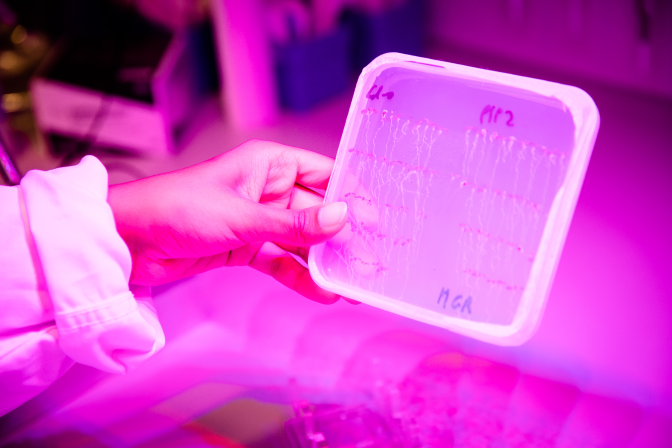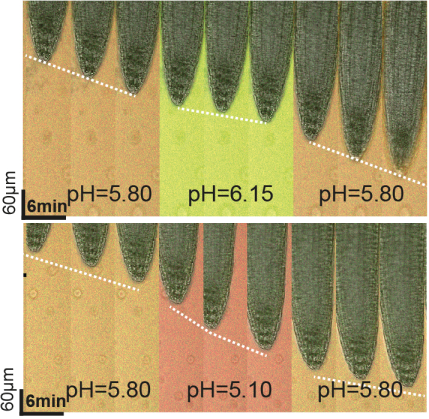October 27, 2021
Stop and Grow
Researchers at IST Austria discover a dual mechanism that helps roots navigate complex terrain.

From stretching towards the sun to making seeds – plants need the hormone auxin to grow. In their roots, however, it inhibits growth. Researchers at the Institute of Science and Technology (IST) Austria now discovered a new mechanism allowing roots to quickly react to obstacles and find suitable soil. With their study published in the journal Nature the team fundamentally increases the knowledge on root development, which could help agriculture find better performing plants.
Being a root is not easy. In search for nutrients, it has to find its way through patches of dense soil, patches with too little or far too much water and grow around rocks. In order to master these challenges, plant roots need a fine balance between growing and stopping. “If your car would only have a gas pedal during rush hour you would quickly cause a traffic jam. So you really need a brake as well,” says first author Inge Verstraeten, until recently Postdoc in Professor Jiří Friml’s research group. Together with co-first author Lanxin Li, she discovered two counteracting mechanisms allowing the roots of the mouse-ear cress, Arabidopsis thaliana, to very quickly modulate their growth. For their comprehensive study, the Friml Group joined forces with researchers from, amongst others, the Belgium VIB Center for Plant Systems Biology, the Dutch Wageningen University, and the Japanese Nagoya University.


Faster than gene transcription
In order to take a close look at the processes within Arabidopsis roots, the biologists used a vertical confocal microscope – a tool especially developed at IST Austria. Instead of a horizontal stage it has a vertical one, enabling researchers to study plants in real-time the way they actually grow: roots down and shoot up. For their experiment, Lanxin Li, Inge Verstraeten, and their colleagues put the roots in little liquid chambers to easily change the amount of the plant hormone auxin in the growing medium. Previously, it was believed that auxin worked through regulating gene transcription.
Yet, what the team observed pointed into a different direction. “We increased the auxin level and immediately saw the how the roots stopped growing. After washing it out, within seconds we saw that the roots were growing again,” describes postdoc Inge Verstraeten. This immediate response of the roots was far too fast to be explained by activating genes in the plant cell’s nucleus.
Sour cells
Unlike the cells of animals, plant cells have rather solid walls. In order for them to grow, auxin makes the cell walls less rigid so the cell can take in more water and expand. It does so by causing molecules to pump protons into the cell walls leading to their acidification. In roots, however, the researchers witnessed the opposite effect – there was an alkalinization of the cell walls.

(c)Inge Verstraeten IST Austria
“It was the only thing we could relate to the very rapid response of the root to the auxin,” says Verstraeten. But when looking at the proton pumps in the cells’ membrane the team was flabbergasted. Like in the shoot, protons were pumped into the cell walls, which should have led to the cell walls becoming more acidic instead of alkaline. “It took us a long time to accept the fact that the root needs both – the export of protons from the cell wall and the import of protons into the cell wall. It works like a simultaneous gas/brake mechanism,” the plant scientist says. Ruling out other options, the team was able to identify the enzyme and mechanism, by which auxin activates the proton pumps in the cells’ membrane leading to the acidification of the cell walls. Via a different, so far still mysterious signaling pathway auxin promotes the efflux of protons, causing the alkalinization of the cell walls.
Together, the two mechanisms balance each other out enabling a fine-tuned growth modulation. “In agriculture, plants are needed that are able to quickly adjust to a changing soil environment. Knowing what we know now can help select plants that are better suited,” Inge Verstraeten explains. Next, Jiří Friml and his team at IST Austria are looking into how exactly auxin is perceived within the roots and what other factors guide the alkalinization of the cell walls.
Publication:
Lanxin Li, Inge Verstraeten & et al. 2021. Cell surface and intracellular auxin signaling for H+-fluxes in root growth. Nature. DOI: 10.1038/s41586-021-04037-6
Funding information:
The IST Austria project part was supported by funding from the European Research Council Advanced Grant, the Austrian Science Fund and the European Union’s Horizon 2020 research and innovation programme under the Marie Skłodowska-Curie Grant Agreement No. 665385 and the DOC Fellowship of the Austrian Academy of Sciences.



